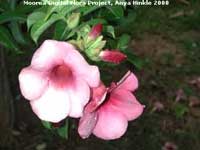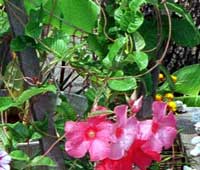|
Identification:
This woody, self supporting vine grows up to 2 m (6.5 ft) tall. Stems, leaves, and seedpods produce a milky white sap when broken. This sap has toxic
properties that are harmful to humans and can cause burning rashes and blisters. When dry, a powdery dust emerges and can cause coughing, nose swelling and eyelid blisters. Glossy leaves 6-10 cm (2.3-4 in) long by 3-5 cm (1-2 in) wide in an opposite arrangement. The funnel shaped, 5 petaled flowers are white to light purple in color. Seed pods are rigid and appear at the end of the stalk.
Impacts: Rubber vine is a notorious invader in Australia. First introduced for ornament around 1860 it was later planted for rubber production. The seeds spread rapidly by wind, floodwaters, and mud, sticking to machinery and in the hooves of animals. In Australia, it forms dense impenetrable thickets by climbing up trees and covering them. It has the ability to choke out native vegetation. In addition, rubber vine is an expensive problem for ranchers in Australia who must control the toxic plant from cattle and horses.The seeds spread rapidly by wind, floodwaters, and mud, sticking to machinery and in the hooves of animals. The milky sap can cause burning rashes and blisters. When dry, a powdery dust emerges and may caus coughing, nose swelling and eyelid blisters.
Dispersal Mechanism: Plants are originally dispersed long distances by humans. Numerous seeds with tufts of silky hairs help disperse the seeds in the wind. Seed pods contain hundreds of white seeds with propellers. Rubber vine is currently only known to grow in a few locations in Maui County (see map) and the Big Island Hawaii. If you see it anywhere else on Kauai, Maui, Molokai, Lanai, or the Big Island- let someone know!
More information about this pest 
|
|
Purple allamanda (Allamanda violacea):
This showy vine has similar flowers to rubber vine and also produces a milky sap when leaves are broken. Purple allamanda has a 3-4 leaf whorled (arranged like spokes on a wheel) leaf growth pattern, while rubber vine's leaves are arranged in an opposite pattern.
|

|
|
Allamanda (Mandevilla species)
|
|
|
Brazilian Jasmine (Mandevilla sanderi):
This is another sap producing vine used in landscaping and gardens. Brazilian jasmine can be differentiated from rubber vine by the color of its trumpet shaped flowers, which are pink to red in color with white to gold throats and are up to 4 in (10 cm) across. This plant is considered a safer alterative to rubber vine for garden planting.
|

|
|
Brazilian Jasmine (Mandevilla sanderi)
|
|